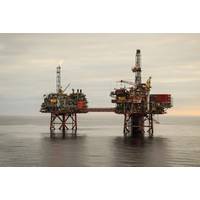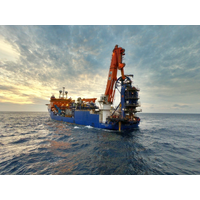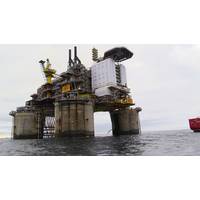Sources: Exxon will sell its older Permian assets for $1 billion to Hilcorp
Four sources with knowledge of the matter said that Exxon Mobil Corp, the top U.S. oil company, has agreed to sell its conventional oil drilling assets located in the Permian basins of Texas and New Mexico for a price around $1 billion to Hilcorp Energy. This deal is part of a growing trend among U.S. oil companies to sell off older properties after a wave of record-breaking acquisitions. Hilcorp, a private operator, has been one of the most active buyers. Exxon confirmed that the assets had been sold but refused to reveal the buyer or the valuation.
Schlumberger Debuts At-bit Steerable System

Schlumberger Introduces At-Bit Steerable System for Drilling Horizontal Wells in a Single RunNeoSteer at-bit steerable system design integrates a unique cutting structure and steering mechanismsSchlumberger introduced today the NeoSteer at-bit steerable system (ABSS) at Society of Petroleum Engineers Annual Technical Conference and Exhibition (SPE ATCE). The NeoSteer ABSSs improve horizontal well drilling performance by providing high-dogleg capability and increased rate of penetration in the curve and the lateral.Developed as a fit-for-basin solution…
Tendeka Launches FloFuse

Independent global completions service company Tendeka said it has launched a new technology that increases oil recovery by improving injected water conformance in fractured reservoirs or by ensuring effective placement of matrix stimulation acids.When installed across a segmented wellbore, FloFuse autonomously chokes back injection into thief zones or large fractures that dominate the outflow profile and ensures effective injection into the rock matrix or fracture structure. This prevents early water breakthrough into production wells…
Chevron Gets Green Light for Captain EOR

Energy giant Chevron announced Tuesday it has received approval from the U.K. Oil and Gas Authority (OGA) to move ahead with its plans for an Enhanced Oil Recovery (EOR) project that aims to unlock millions of extra barrels of oil and extend the life of the long-producing Captain field in the U.K. Central North Sea.Chevron North Sea Limited (CNSL), which operates Captain as 85 percent stakeholder, said its plan includes applying polymer injection technology to increase production and help maximize economic recovery from the field located approximately 145 kilometers northeast of Aberdeen.
McDermott Completes Phase 1 of QGEP Atlanta EPS

McDermott International, Inc. has announced it completed the first phase of the deep-water Atlanta Early Production System (EPS), located approximately 115 miles (185 kilometers) offshore southeast of Rio de Janeiro, for independent Brazilian Exploration and Production company Queiroz Galvão Exploração e Produção S.A. (QGEP). McDermott successfully performed the project management, engineering and offshore installation of all subsea hardware, including flexible pipes, umbilicals, umbilical termination assemblies, and associated equipment for the subsea umbilicals, risers and flowlines (SURF) project.
US DOE Directs $30 Mln to Small Oil, Gas Projects
Six small U.S. oil and natural gas drilling projects will receive about $30 million in federal funding for research and development to help achieve President Donald Trump's policy of boosting output of fossil fuels, the Energy Department (DOE) said on Wednesday. The projects, selected by the DOE under the direction of Congress, are in what is known as unconventional shale development. They currently produce less than 50,000 barrels per day each. Unconventional oil and gas production uses advanced techniques such as hydraulic fracturing…
Chevron Approves New Tech in North Sea
U.S. oil major Chevron has approved an investment to increase output from its Captain oilfield by using a new water-injection technology for the first time in the North Sea, the company said on Friday. Six long-reach horizontal wells will be drilled in the 20-year-old field, around 90 miles northeast of Aberdeen. They are expected to raise the recovery rate 5 to 7 percent. Polymerised water will be injected into the field's oil reservoir, a new technique to tap oil reserves that are hard to reach with conventional drilling methods.
Tendeka Wins Lower Completion Contract in Middle East

Tendeka has been awarded a project to supply the Kuwait Oil Company (KOC) with its Inflow Control Device (ICD) technology which will enhance production through more effective reservoir management. The multimillion-pound deal will involve Tendeka installing Advanced ICD equipment in 55 horizontal wells over two years in Northern Kuwait. Tendeka will perform reservoir simulations for each well, working closely with KOC to ensure optimum reservoir performance. Tendeka has installed over 7,000 passive ICDs and 20,000 autonomous ICDs globally.
YPF Says Technology Lowering Its Shale Costs
Longer horizontal wells and technology improvements will help Argentine state-run oil company YPF SA lower costs at its most productive shale field, but better infrastructure is still needed in the remote Vaca Muerta play, an executive said. The breakeven price at the Loma Campana field is $43 per barrel and falling while development costs are $12.90 per barrel and expected to fall to $10 next year, said Pablo Bizzotto, executive manager at YPF's unconventional resources unit. "Ten dollars is world-class compared with the Permian" shale field in Texas…
Halliburton Signals Better Demand for Fracking Equipment
Halliburton Co indicated that demand for its fracking equipment was returning, despite the fewer number of rigs at work, as high-intensity shale drilling soaked up all the available capacity in the market. Halliburton is the world's largest provider of equipment used in hydraulic fracturing or fracking - the process of pumping water and chemicals, known as proppants, into shale rocks to extract oil and gas. U.S. shale oil producers - Halliburton's customers - are now drilling longer horizontal wells with multiple fracking stages, and deploying more horsepower and proppants to cover larger areas.
Recent Drilling has Lowered Costs, Increased Performance
The profitability of oil and natural gas development activity depends both on the prices realized by producers and the cost and productivity of newly developed wells. Overall trends in well development costs are generally less transparent than those in price and productivity, which are readily observable in the markets or through analyses of well productivity trends such as EIA's monthly Drilling Productivity Report. To better understand the costs of upstream (or, wellhead) drilling and production activity, the U.S. Energy Information Administration (EIA) commissioned IHS Global Inc.
Russian Rig Demand Changes Direction -Douglas Westwood
In 2015, Russian onshore drilling bucked global activity trends and reached record highs. Depreciation of the rouble cushioned the Russian oil industry, incentivizing operators to boost activity and pay for services in roubles while gaining dollars on international markets. Last year, the global number of onshore wells drilled decreased 31%, yet the Russian market – notable for its comparative resilience – experienced year–on–year growth of 6%. Unfortunately, 2016 is not shaping up to be a bumper year.
Argentina's YPF Will Cut Capital Expenditure in 2016
Argentina's state-controlled oil company YPF will cut its capital expenditure in 2016 to mitigate the impact of the global oil price rout, its chief executive said on Friday after the firm announced a fourth quarter loss. "We do not see a meaningful production growth this year, we will be cutting capex," Chief Executive Officer Miguel Galuccio told an investor conference call. He did not immediately give further details but said some working rigs had already been put into standby mode.
Rosneft, Statoil Start Well Testing at North-Komsomolskoye Field
Rosneft and Statoil commenced testing of two production wells of highly viscous oil of the PK1 layer of the North-Komsomolskoye field. The companies are implementing pilot operation of the horizontal wells constructed using best practices related to inflow control and consolidation of entrained solids. Average starting flowrate amounts to 75 t per day, whilst oil production potential is being estimated over 100 t per day for one well. Such results demonstrate strong synergy effect of the experience and expertise of Rosneft and Statoil.
U.S. Shale Oil Output Will Be Less Resilient Than Gas: Kemp
U.S. natural gas production hit a new record in August, despite the deepening slump in gas prices and a fall in the number of rigs targeting gas formations. The failure of gas production to respond to lower prices and a falling rig count has left many analysts wondering if it heralds the same problem in the oil market - worsening oversupply. The number of rigs drilling for oil has plunged almost two-thirds over the last 12 months, but crude production is unchanged since October 2014 and down by less than 5 percent compared with its peak in April.
U.S. Output Slide Looms as Shale Hits 'Wall'
Stagnating rig productivity shows U.S. shale oil producers are running out of tricks to pump more with less in the face of crashing prices and points to a slide in output that should help rebalance global markets. Over the 16 months of the crude price rout, production from new wells drilled by each rig has risen about 30 percent as companies refined their techniques, idled slower rigs and shifted crews and high-speed rigs to "sweet spots" with the most oil. Such "high-grading" helped shale oil firms push U.S.
DW: Frac Truck Boneyards

In the desert of New Mexico, just forty miles from producing wells in Artesia, lies an aircraft boneyard filled with the remains of once great aeroplanes. Like these planes, nearly 4,000 frac trucks are sitting idle throughout the United States as the demand for horsepower (HP) has fallen as quickly as WTI over the past year. Could there be potential for these trucks to be utilized again, or will frac trucks join aeroplanes in boneyards across Texas and North Dakota? From 2011-2014 frac pump manufacturers were in a race to see how fast horsepower could be added to the United States’ frac fleet.
Troll Oil Celebrates 20 Years

This week it is 20 years since the start of oil production from the Troll field. 1.56 billion barrels have been produced so far and NOK 460 billion ($53.7 billion) in income realized. “Troll oil is the impossible made possible. Only a few believed in extracting the thin oil zone at Troll, and through a burning desire to make it happen, determination and innovation, Troll oil became reality,” says Øivind Dahl-Stamnes, head of Troll production. Determination and innovation in reservoir technology…
Rosneft Production Up 27% in 7 Months
Rosneft increased technical drilling volumes at the Company’s production assets by 27% in 7 months of 2015. Based on the January through July 2015 results the overall drilling progress accounted to 4.585 mln m, whilst during the same period of 2014 the figure was 3.605 mln m. Efficient technical drilling increase is a key priority for Rosneft’s upstream business dimension, which allows cost-efficient maintaining production at brownfields, and increasing production at greenfields. Key factors…
Argentina Cuts Shale Drilling Costs
Argentina needs $200 billion in investment to develop its vast but barely tapped shale fields, but no joint ventures were expected soon because of low oil prices and uncertainty ahead of a presidential election, state oil company YPF said on Thursday. YPF, nationalized in 2013, is improving drilling efficiency and developing its Vaca Muerta shale formation in Patagonia so that international companies will invest once prices recover, Chief Financial Officer Daniel Gonzalez said in a conference call with investors. "I would not expect any significant joint ventures to be announced soon," Gonzalez said.
